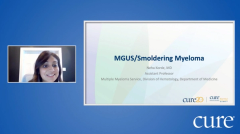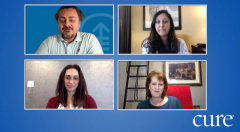
Educated Patient® Multiple Myeloma Summit Upcoming FDA Approvals Presentation: March 12, 2022
Watch Dr. Cesar Rodriguez, of the Multiple Myeloma Program at the Ichan School of Medicine at Mount Sinai, discuss upcoming FDA approvals in the space, during the CURE Educated Patient Multiple Myeloma Summit.
There are more treatment options than ever for patients with multiple myeloma, and as clinical trials continue to show promise of up-and-coming regimens, patients can expect to see more newly approved therapies in the future.
To get approved by the Food and Drug Administration (FDA), a new treatment regimen must be tested first in a small, phase 1 clinical trial, which looks at safety, side effects, dosing and delivery method (injection, pill, intravenous delivery, etc.). Then, a larger phase 2 trial looks at how well the drug works and how safe it is. Finally, a phase 3 trial compares the investigational therapy to the current standard of care for a particular setting or indication.
“The FDA has the ability to approve one of these treatments to become standard of care either at phase 3 of a study,” explained Dr. Cesar Rodriguez, associate professor and clinical director of the Multiple Myeloma Program at the Ichan School of Medicine at Mount Sinai.
At the CURE® Educated Patient® Multiple Myeloma Summit, held March 12, Rodriguez provided an overview of new therapies that patients may see approved within the next year or so.
Teclistamab
While new regimens have been added to the myeloma space in recent years, there is still an unmet need for patients with relapsed/refractory myeloma who have previously been exposed to three or more types of therapies.
Teclistamab is an off-the-shelf (meaning that it is not made with the patient’s own blood) T-cell redirecting bispecific antibody that mediates T-cell activity and the attacking of myeloma cells that express BCMA.
“The way I want to think about the bispecific antibody is, imagine that we’re introducing some proteins in the blood that have two arms. One arm binds to the myeloma cell from a marker or protein that’s on the surface of that cell, and the other arm is going to bind to the T cell or the immune cell through a protein that’s on the surface of that cell,” Rodriguez explained. “And once it has both of them in its hands, it’s going to activate the immune cell or the T cell so that it can destroy the myeloma cell.”
In the phase 1/2 MajesTEC-1 clinical trial, 62% of patients with triple-class exposed myeloma responded to the treatment, with an average time to response being 1.2 months. In patients who achieved a complete response (meaning that there is no sign of the cancer after treatment), 41.9% were declared to be minimal residual disease (MRD) negative, meaning that clinicians could not find any leftover signs of remaining disease.
While 71.5% of patients on the study experienced cytokine release syndrome – a common side effect of chimeric antigen receptor (CAR)-T cell therapies where the body releases too many inflammatory molecules called cytokines – all events were resolved, and nobody had to stop treatment due to the condition.
“The fact that this therapy is showing so many positive responses in people who are heavily pretreated… that’s what’s causing us to believe that this is going to be the next drug approved by the FDA,” Rodriguez said. “Now we believe it might be at the end of the year, but the information is still not out.”
Iberdomide
Iberdomide is another drug whose promising responses may lead to FDA approval. This is an immunomodulary drug, similar to previously approved agents like Revlimid (lenalidomide) and Pomalyst (pomalidomide).
“The interesting thing about this drug is that even people who have been already treated with (Revlimid) and (Pomalyst) and are refractory to these agents and progressed on these medicines, there’s still some benefit (with iberdomide),” Rodriguez said.
In the CC-220-MM001 phase 1/2 clinical trial, 26.2% of patients responded to therapy with iberdomide plus dexamethasone. In patients who had already received a BCMA-targeted therapy, the response rate was 25%.
While Rodriguez said that those numbers “do not sound very impressive” compared to some other up-and-coming therapies, he stressed that iberdomide has similar efficacy to other drugs in the setting, is easy to take as an oral agent and is well-tolerated.
Looking Ahead to 2023
Treatments for myeloma will continue to evolve beyond this year.
Rodriguez said that patients can expect to see the further development and future approval of ABBV-383, a bispecific antibody that may be able to minimize cytokine release syndrome. Also coming down the pipeline is cevostamab and REGN5458, two other bispecific antibodies that are each showing particular promise in their respective phase 1 trials for patients with heavily pretreated, relapsed/refractory myeloma.
“The (drugs) I presented for 2023 are still a bit in diapers. We need to identify what’s going to be the right dose, what the right frequency of medication (is), if we’re going to be using an IV or subcutaneously… Phase 2 (trials are where) the FDA can decide if it’s something that’s safe for patients and is more effective and beneficial than the current therapies available,” Rodriguez said.
For more news on cancer updates, research and education, don’t forget to















